Our undergoing projects

The potential of flower strips with trees to improve the resilience of bumblebees to climate change in Quebec
Student: Kévin Matte; collaborator: Marc J. Mazerolle (Université Laval)
Climate change is having a major impact on biodiversity in Quebec. One of these effects, rising temperatures, could be responsible for the marked decline in certain pollinators, such as bumblebees. The aim of the project is to establish management strategies to improve the resilience of bumblebee populations on farms. This study will provide a better understanding of the capacity and behaviour of bumblebees when facing temperature rises in their natural environment. It will also help to better understand the positive or negative effects that the type of surrounding environment can have. We will study the impact of rising temperatures on commercial colonies of bumblebees placed in control fields, flower strips, and flower strips with trees. Finally, the results will be used to advise on the best ways to increase the resilience of bumblebee colonies in agricultural environments.
Student: Kévin Matte; collaborator: Marc J. Mazerolle (Université Laval)
Climate change is having a major impact on biodiversity in Quebec. One of these effects, rising temperatures, could be responsible for the marked decline in certain pollinators, such as bumblebees. The aim of the project is to establish management strategies to improve the resilience of bumblebee populations on farms. This study will provide a better understanding of the capacity and behaviour of bumblebees when facing temperature rises in their natural environment. It will also help to better understand the positive or negative effects that the type of surrounding environment can have. We will study the impact of rising temperatures on commercial colonies of bumblebees placed in control fields, flower strips, and flower strips with trees. Finally, the results will be used to advise on the best ways to increase the resilience of bumblebee colonies in agricultural environments.

Quantify exposure related to pesticide residues in the pollen and nectar of wild and cultivated plants for native pollinators.
Student: Michaël Tremblay; collaborator: Sabrina Rondeau (University of Guelph, University of Ottawa)
Nearly 90% of all plant species, including 75% of the major crop species cultivated for our food, depend on animal pollination for reproduction. However, the observed decline of these pollinators poses a threat to both food security and biodiversity. Agricultural intensification and intensive pesticide use are major factors contributing to this decline. Pollinators are exposed to pesticides through various pathways, including the consumption of contaminated pollen and nectar. This project aims to quantify pesticide’s residues in the pollen and nectar of wildflowers bordering fields, as well as flowers from different crops practiced in Quebec, including cranberries, apples, and squash. These data will help evaluate the possibility of predicting pesticide concentrations in nectar based on those detected in pollen, which could facilitate risk assessment for pollinators. Furthermore, in order to minimize their exposure, a safe distance between pesticide application points and wild plants will be determined to guide farmers in their agricultural practices.
Student: Michaël Tremblay; collaborator: Sabrina Rondeau (University of Guelph, University of Ottawa)
Nearly 90% of all plant species, including 75% of the major crop species cultivated for our food, depend on animal pollination for reproduction. However, the observed decline of these pollinators poses a threat to both food security and biodiversity. Agricultural intensification and intensive pesticide use are major factors contributing to this decline. Pollinators are exposed to pesticides through various pathways, including the consumption of contaminated pollen and nectar. This project aims to quantify pesticide’s residues in the pollen and nectar of wildflowers bordering fields, as well as flowers from different crops practiced in Quebec, including cranberries, apples, and squash. These data will help evaluate the possibility of predicting pesticide concentrations in nectar based on those detected in pollen, which could facilitate risk assessment for pollinators. Furthermore, in order to minimize their exposure, a safe distance between pesticide application points and wild plants will be determined to guide farmers in their agricultural practices.

Improving bumblebee health and nutrition in agricultural landscapes: Optimizing floral mixes
Student: Amélie Morin; collaborator: Mathilde Tissier (Centre National de la Recherche Scientifique) and Virginie Durand (UPA)
In Canada, several bumblebee species are endangered, raising major concerns for food security and ecosystem resilience. Maintaining high-quality nutritional food sources to promote their health in agricultural ecosystems is currently a significant challenge. The project is divided into three sub-objectives aimed at: 1) Characterizing the nutritional and medicinal profiles of floral resources consumed by bumblebees, 2) Identifying the nutritional deficiencies of endangered bumblebees in Quebec, the contaminants and pathogens affecting them, as well as the floral resources they consume, and 3) Identifying nutritious and medicinal mixes for floral strip arrangements that promote bumblebee health and reproduction. To address these objectives, we will evaluate the effect of pollens on the behavior, health, and performance of bumblebees. We will also establish an experimental setup that will allow us to compare the effect of three types of floral mixes on the health, performance, and behavior of bumblebees. The knowledge gained will enable us to provide precise recommendations to support bumblebee reproduction while improving their overall health status for conservation purposes.
Student: Amélie Morin; collaborator: Mathilde Tissier (Centre National de la Recherche Scientifique) and Virginie Durand (UPA)
In Canada, several bumblebee species are endangered, raising major concerns for food security and ecosystem resilience. Maintaining high-quality nutritional food sources to promote their health in agricultural ecosystems is currently a significant challenge. The project is divided into three sub-objectives aimed at: 1) Characterizing the nutritional and medicinal profiles of floral resources consumed by bumblebees, 2) Identifying the nutritional deficiencies of endangered bumblebees in Quebec, the contaminants and pathogens affecting them, as well as the floral resources they consume, and 3) Identifying nutritious and medicinal mixes for floral strip arrangements that promote bumblebee health and reproduction. To address these objectives, we will evaluate the effect of pollens on the behavior, health, and performance of bumblebees. We will also establish an experimental setup that will allow us to compare the effect of three types of floral mixes on the health, performance, and behavior of bumblebees. The knowledge gained will enable us to provide precise recommendations to support bumblebee reproduction while improving their overall health status for conservation purposes.

Ecology of leafhoppers in strawberry fields in Quebec
Student in co-supervision: Jordanne Jacques; principal investigator: Edel Pérez-López (Université Laval)
Climate change has a significant impact on agriculture and insect pests. Higher temperatures alter insect ranges, contribute to their winter survival and accelerate their development. In Quebec, the increase of leafhoppers in strawberry fields has led to an increased use of pesticides, which is a cause for concern for both the strawberry industry and the environment. The aim of this project is to study the diversity of leafhoppers in Quebec strawberry fields, the effects of climate change on their abundance and the presence of parasitoids associated with them. The results will allow us to assess the genus diversity of leafhoppers in Quebec strawberry fields, to determine the correlation between climatic parameters and their abundance and to identify their natural enemies present in strawberry fields. The results of this study will provide avenues for more sustainable management of these pests in strawberry fields in Quebec.
Student in co-supervision: Jordanne Jacques; principal investigator: Edel Pérez-López (Université Laval)
Climate change has a significant impact on agriculture and insect pests. Higher temperatures alter insect ranges, contribute to their winter survival and accelerate their development. In Quebec, the increase of leafhoppers in strawberry fields has led to an increased use of pesticides, which is a cause for concern for both the strawberry industry and the environment. The aim of this project is to study the diversity of leafhoppers in Quebec strawberry fields, the effects of climate change on their abundance and the presence of parasitoids associated with them. The results will allow us to assess the genus diversity of leafhoppers in Quebec strawberry fields, to determine the correlation between climatic parameters and their abundance and to identify their natural enemies present in strawberry fields. The results of this study will provide avenues for more sustainable management of these pests in strawberry fields in Quebec.
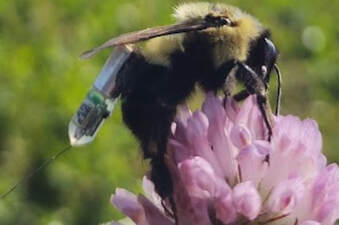
Artificial nesting structures and overwintering sites for bumblebees in fruit crops in Quebec
Student: Lydia Millette-St-Hilaire; collaborator: Amélie Gervais
Bumblebees are excellent pollinators for many cultures, including highbush blueberries, cranberry, and apples. However, bumblebees suffer decline caused in part by the reduced availability of nesting and overwintering habitats on farms. For bumblebee’s conservation, it is important to learn more about these two critical phases of their life cycle. This study will assess the efficacy of artificial nest boxes (wooden underground, wooden aboveground, under a concrete slab, or in a terracotta pot) on apples, highbush blueberries and cranberries farms. In addition to studying the bumblebees, the nest boxes will provide nesting sites, which will help their conservation. The project will also characterize overwintering sites and bumblebee dispersal in the fall through telemetry.
Student: Lydia Millette-St-Hilaire; collaborator: Amélie Gervais
Bumblebees are excellent pollinators for many cultures, including highbush blueberries, cranberry, and apples. However, bumblebees suffer decline caused in part by the reduced availability of nesting and overwintering habitats on farms. For bumblebee’s conservation, it is important to learn more about these two critical phases of their life cycle. This study will assess the efficacy of artificial nest boxes (wooden underground, wooden aboveground, under a concrete slab, or in a terracotta pot) on apples, highbush blueberries and cranberries farms. In addition to studying the bumblebees, the nest boxes will provide nesting sites, which will help their conservation. The project will also characterize overwintering sites and bumblebee dispersal in the fall through telemetry.
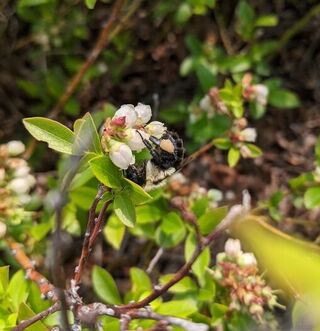
Management methods of commercial bumblebee (Bombus impatiens) colonies to optimise their performance during the lowbush blueberry (Vaccinium angustifolium) pollination
Student in co-supervision: Anne-Charlie Robert; collaborator: Pierre Giovenazzo (Université Laval)
Because of their high efficiency to pollinate crops, the importance of commercial bumblebees (Bombus impatiens) is growing for the agricultural businesses, among which the lowbush blueberry (Vaccinium angustifolium) industry. The methods to manage these commercial colonies are still unknown and should be explored to maximize their productivity during blueberry pollination. This study’s goal is to determine which sunlight and installation management methods encourage a higher foraging activity and healthier colonies. Bombus impatiens colonies were installed in a lowbush blueberry field in La Doré, Lac-Saint-Jean, at different moments. Half of the colonies were protected against direct sunlight, while the other half was not. How these methods influence the foraging activity of the foragers, and the growth and health of the colonies will be analyzed. These results will allow us to optimise the commercial bumblebee colonies’ management, which will then allow the blueberry producers to make the most profit out of their bumblebee use in the fields.
Student in co-supervision: Anne-Charlie Robert; collaborator: Pierre Giovenazzo (Université Laval)
Because of their high efficiency to pollinate crops, the importance of commercial bumblebees (Bombus impatiens) is growing for the agricultural businesses, among which the lowbush blueberry (Vaccinium angustifolium) industry. The methods to manage these commercial colonies are still unknown and should be explored to maximize their productivity during blueberry pollination. This study’s goal is to determine which sunlight and installation management methods encourage a higher foraging activity and healthier colonies. Bombus impatiens colonies were installed in a lowbush blueberry field in La Doré, Lac-Saint-Jean, at different moments. Half of the colonies were protected against direct sunlight, while the other half was not. How these methods influence the foraging activity of the foragers, and the growth and health of the colonies will be analyzed. These results will allow us to optimise the commercial bumblebee colonies’ management, which will then allow the blueberry producers to make the most profit out of their bumblebee use in the fields.
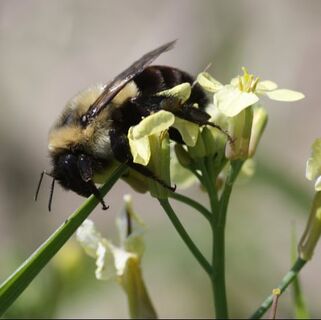
Evaluation of the impact of the composition and structure of sown flower strips along the edge of fields as a tool for the conservation of bumblebees in Montérégie
Student: Amélie Morin; collaborator: Virginie Durand (UPA)
Pollinators have been declining significantly in recent decades. A frequently used conservation tool is the creation of flower strips along the edges of fields. They aim to provide quality habitat and food resources for pollinators. The maintenance of these strips, their width and their composition in floral species can influence the response of pollinators. The objective of this project is to evaluate the impact of the floral species composition and width of flower strips on the abundance and species richness of bumblebee populations in Montérégie. To do so, the project will be carried out on 24 field crop farms in this region. Different seed mixtures and different strip widths will be studied. A monthly inventory of bumblebee populations will be carried out locally and at the farm level. Finally, this project will determine the characteristics that flower strips must have to be effective conservation tools for bumblebee species in Quebec.
Student: Amélie Morin; collaborator: Virginie Durand (UPA)
Pollinators have been declining significantly in recent decades. A frequently used conservation tool is the creation of flower strips along the edges of fields. They aim to provide quality habitat and food resources for pollinators. The maintenance of these strips, their width and their composition in floral species can influence the response of pollinators. The objective of this project is to evaluate the impact of the floral species composition and width of flower strips on the abundance and species richness of bumblebee populations in Montérégie. To do so, the project will be carried out on 24 field crop farms in this region. Different seed mixtures and different strip widths will be studied. A monthly inventory of bumblebee populations will be carried out locally and at the farm level. Finally, this project will determine the characteristics that flower strips must have to be effective conservation tools for bumblebee species in Quebec.
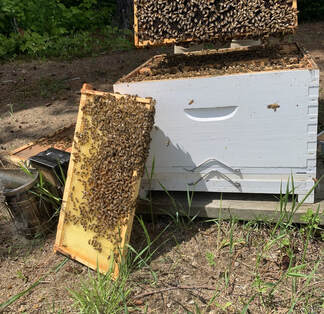
Relationship between foraging activity and the populational structure of brood and worker bees in domestic bee swarms (Apis mellifera L.)
Student in co-supervision: Kim Ménard; collaborator: Pierre Giovenazzo (Université Laval)
In the province of Québec, honeybee is the most used species for lowbush blueberry pollination services. This colony strength is established in number of bee frames and the rental cost varies depending on this evaluation. However, since a proportion of the bees evaluated are young nurse workers who take care of the brood and don’t participate in foraging activities, the number of foragers doesn’t follow a linear relation with the number of bee frames. Therefore, an evaluation of the strength only based on bee frames, not taking into account the quantity of brood, and not distinguishing the foragers from the nurses isn’t a precise representation of the pollination capacity of a colony. This study aims to determine the optimal structure of brood and bees quantity in a colony, so that the pollination and beekeeping management of apiarists are optimized. The study will be conducted during two summers (2022-2023). On the first year, we will determine the best populational structure to optimize the foragers’ number in a honeybee colony. The second year, we will test this populational structure in lowbush blueberry pollination conditions, at the Lac Saint-Jean. The pollination optimization resulting from this project will increase the fruits’ production and quality for the blueberry growers and thus their income. The beekeepers will also see an increase in their income, due to the efficiency rise of their colony management in relation with the pollination services growing demand.
Student in co-supervision: Kim Ménard; collaborator: Pierre Giovenazzo (Université Laval)
In the province of Québec, honeybee is the most used species for lowbush blueberry pollination services. This colony strength is established in number of bee frames and the rental cost varies depending on this evaluation. However, since a proportion of the bees evaluated are young nurse workers who take care of the brood and don’t participate in foraging activities, the number of foragers doesn’t follow a linear relation with the number of bee frames. Therefore, an evaluation of the strength only based on bee frames, not taking into account the quantity of brood, and not distinguishing the foragers from the nurses isn’t a precise representation of the pollination capacity of a colony. This study aims to determine the optimal structure of brood and bees quantity in a colony, so that the pollination and beekeeping management of apiarists are optimized. The study will be conducted during two summers (2022-2023). On the first year, we will determine the best populational structure to optimize the foragers’ number in a honeybee colony. The second year, we will test this populational structure in lowbush blueberry pollination conditions, at the Lac Saint-Jean. The pollination optimization resulting from this project will increase the fruits’ production and quality for the blueberry growers and thus their income. The beekeepers will also see an increase in their income, due to the efficiency rise of their colony management in relation with the pollination services growing demand.
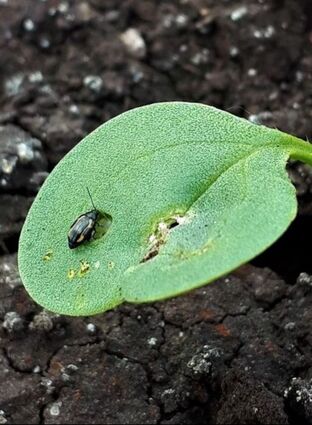
Monitoring flea beetle populations in radish in organic soil and evaluating mass trapping for damage control
Student: Laurence Fleury; collaborator: Anne-Marie Fortier (Compagnie de recherche Phytodata)
The crucifer flea beetle (Phyllotreta crucifera) and the stripped flea beetle (Phyllotreta striolata) are major pests of crucifer crops. The adults feed on the leaves and the subsequent defoliation can completely destroy the young plants. The larvae also damage root crops by burrowing for food. In recent years, the damage caused by adults and larvae may have been so severe that some fields of radish and daikon had to be abandoned as a result. No relationship between the intensity of the adult populations and the damage caused by their larvae could be established so far. The project will therefore first verify the existence of a potential correlation between the screening and trapping of adults and the screening of larval damage. Secondly, the effectiveness of damage control methods such as mass trapping and the use of exclusion nets in cover and fencing will be evaluated.
Student: Laurence Fleury; collaborator: Anne-Marie Fortier (Compagnie de recherche Phytodata)
The crucifer flea beetle (Phyllotreta crucifera) and the stripped flea beetle (Phyllotreta striolata) are major pests of crucifer crops. The adults feed on the leaves and the subsequent defoliation can completely destroy the young plants. The larvae also damage root crops by burrowing for food. In recent years, the damage caused by adults and larvae may have been so severe that some fields of radish and daikon had to be abandoned as a result. No relationship between the intensity of the adult populations and the damage caused by their larvae could be established so far. The project will therefore first verify the existence of a potential correlation between the screening and trapping of adults and the screening of larval damage. Secondly, the effectiveness of damage control methods such as mass trapping and the use of exclusion nets in cover and fencing will be evaluated.
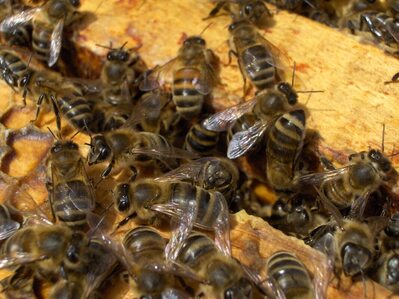
Optimisation of lowbush blueberry pollination by honey bees and bumblebees
Student: Ana María Quiroga Arcila; collaborator: Pierre Giovenazzo (Université Laval)
Canada is the world's leading producer of lowbush blueberry (Vaccinium angustifolium) and Quebec is the main producing province. The rental of honey bee colonies is the main source of pollination services. The cost of this service has been increasing over the last 20 years and represents an expense of more than $4 million for lowbush blueberry producers in Quebec. However, the recommendations concerning the density of honeybee hives and bumblebee hives to be used in lowbush blueberries are still unclear. The goal of this research is to optimize the pollination services of lowbush blueberries by increasing the density of honeybee colonies and to compare the efficiency of pollination by honeybee colonies and bumblebee colonies. The research will be developed entirely in situ in nine typical blueberry fields in the Saguenay-Lac-Saint-Jean region for four consecutive years starting in the summer of 2022. This study will allow the development of a model to estimate the optimal honey bee colony density for the pollination of lowbush blueberries according to the cultural context. The model will also be used to evaluate the pollination efficiency of commercial bumblebee hives.
Student: Ana María Quiroga Arcila; collaborator: Pierre Giovenazzo (Université Laval)
Canada is the world's leading producer of lowbush blueberry (Vaccinium angustifolium) and Quebec is the main producing province. The rental of honey bee colonies is the main source of pollination services. The cost of this service has been increasing over the last 20 years and represents an expense of more than $4 million for lowbush blueberry producers in Quebec. However, the recommendations concerning the density of honeybee hives and bumblebee hives to be used in lowbush blueberries are still unclear. The goal of this research is to optimize the pollination services of lowbush blueberries by increasing the density of honeybee colonies and to compare the efficiency of pollination by honeybee colonies and bumblebee colonies. The research will be developed entirely in situ in nine typical blueberry fields in the Saguenay-Lac-Saint-Jean region for four consecutive years starting in the summer of 2022. This study will allow the development of a model to estimate the optimal honey bee colony density for the pollination of lowbush blueberries according to the cultural context. The model will also be used to evaluate the pollination efficiency of commercial bumblebee hives.

Identification of novel optical plant signals for the early detection of cannabis pests
Student: Simon-Pierre Tchang; collaborator: Xavier Maldague (Université Laval)
Cannabis is a plant with a wide range of pests including several insects, diseases and fungi that can cause stress, sometimes resulting in economic yield losses. In this study, we will determine the impact of stress on cannabis inflicted by pests such as onion thrips (Thrips tabaci (Lindeman)), two-spotted spider mite (Tetranychus urticae) and an aphid species. Observations will be made using multispectral cameras to provide a description of the early optical and visual symptoms of plant stress for each type of pest. These results will be used to create a machine learning algorithm to correlate the presence of a pest based on plant stress signals with an appropriate treatment in terms of economic risk.
Student: Simon-Pierre Tchang; collaborator: Xavier Maldague (Université Laval)
Cannabis is a plant with a wide range of pests including several insects, diseases and fungi that can cause stress, sometimes resulting in economic yield losses. In this study, we will determine the impact of stress on cannabis inflicted by pests such as onion thrips (Thrips tabaci (Lindeman)), two-spotted spider mite (Tetranychus urticae) and an aphid species. Observations will be made using multispectral cameras to provide a description of the early optical and visual symptoms of plant stress for each type of pest. These results will be used to create a machine learning algorithm to correlate the presence of a pest based on plant stress signals with an appropriate treatment in terms of economic risk.
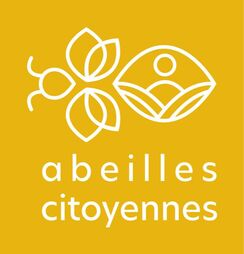
Citizen science to study landscape impact on biodiversity and community compositions of indigenous bees in Québec
Co-principal investigators: Sabrina Rondeau (University of Guelph, University of Ottawa) and Amélie Gervais; research professional: Frédéric McCune
Abeilles citoyennes is a participatory science project aimed at inventorying the biodiversity of wild pollinating insects (bees and syrphids) across Québec. Led by a research team from Université Laval, the project calls on the public for help in collecting data on the distribution and abundance of pollinating species in the main agricultural regions of Québec. It aims to describe and study their diversity according to the characteristics of the landscape.
Project's website : http://abeillescitoyennes.ca/
Co-principal investigators: Sabrina Rondeau (University of Guelph, University of Ottawa) and Amélie Gervais; research professional: Frédéric McCune
Abeilles citoyennes is a participatory science project aimed at inventorying the biodiversity of wild pollinating insects (bees and syrphids) across Québec. Led by a research team from Université Laval, the project calls on the public for help in collecting data on the distribution and abundance of pollinating species in the main agricultural regions of Québec. It aims to describe and study their diversity according to the characteristics of the landscape.
Project's website : http://abeillescitoyennes.ca/
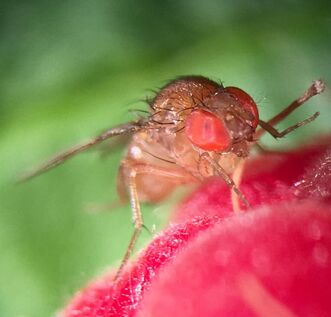
Development of a biological control strategy against the spotted wing drosophila, Drosophila suzukii, using the complementarity of natural enemies in fall-bearing raspberries in Québec
Student: Phanie Bonneau; collaborator: Annabelle Firleij (IRDA)
The spotted wing drosophila, Drosophila suzukii Matsumura (Diptera: Drosophilidae), or SWD, is an invasive pest and is considered a major economic threat to berries in North America and Europe. Unlike other fruit flies that prefer decaying fruit, SWD causes damage to ripe fruits just before harvest, making them unmarketable. In Canada, raspberry, strawberry, blackberry, blueberry and cherry crops have been the main crops affected by SWD since its invasion in 2009. Synthetic insecticides are currently the main control method used against this pest. However, the preharvest intervals between repeated applications, the risk of pesticide residues on fruit and the rotation of available products have created a real headache for Canadian growers struggling with SWD. This PhD research project aims to develop a biological control strategy against SWD, which will provide a promising and sustainable solution for berry growers in Canada.
Student: Phanie Bonneau; collaborator: Annabelle Firleij (IRDA)
The spotted wing drosophila, Drosophila suzukii Matsumura (Diptera: Drosophilidae), or SWD, is an invasive pest and is considered a major economic threat to berries in North America and Europe. Unlike other fruit flies that prefer decaying fruit, SWD causes damage to ripe fruits just before harvest, making them unmarketable. In Canada, raspberry, strawberry, blackberry, blueberry and cherry crops have been the main crops affected by SWD since its invasion in 2009. Synthetic insecticides are currently the main control method used against this pest. However, the preharvest intervals between repeated applications, the risk of pesticide residues on fruit and the rotation of available products have created a real headache for Canadian growers struggling with SWD. This PhD research project aims to develop a biological control strategy against SWD, which will provide a promising and sustainable solution for berry growers in Canada.
Our recently completed projects
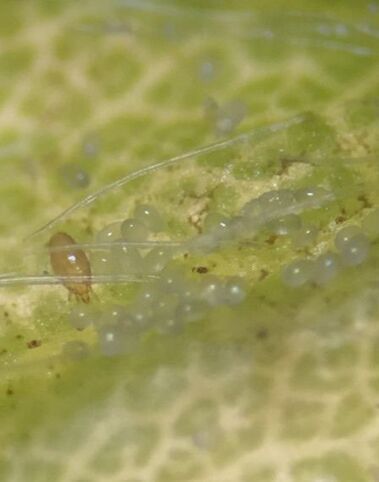
Inventory and study of Hirsutella sp., an entomopathogenic fungus of the cyclamen mite, in order to develop a conservation biological control strategy for strawberry production
Student: Andréa Duclos; collaborators: Russell J. Tweddell (Université Laval), Joseph Moisan-De Serres (MAPAQ), and Stéphanie Tellier (MAPAQ)
The cyclamen mite is an important pest in strawberry cultivation, causing high yield losses with very few control methods available. However, some growers are doing admirably well with very low mite infestations and little or no acaricide application. During exploratory trials conducted in 2020 and 2021 to investigate this phenomenon, we discovered mites naturally mycosed by an indigenous entomopathogenic fungus on seven different strawberry farms. Sequencing of the fungus revealed that it was a fungus of the genus Hirsutella sp. We believe that the presence of entomopathogenic fungi in certain fields facilitates the control of mites and that certain farm practices (crop management, agricultural inputs, etc.) influence the presence of these fungi. The objectives of this project are therefore to determine the distribution of Hirsutella in strawberry fields in Quebec and to identify the factors affecting its distribution, but also to validate the pathogenicity of the fungus against the cyclamen mite.
Student: Andréa Duclos; collaborators: Russell J. Tweddell (Université Laval), Joseph Moisan-De Serres (MAPAQ), and Stéphanie Tellier (MAPAQ)
The cyclamen mite is an important pest in strawberry cultivation, causing high yield losses with very few control methods available. However, some growers are doing admirably well with very low mite infestations and little or no acaricide application. During exploratory trials conducted in 2020 and 2021 to investigate this phenomenon, we discovered mites naturally mycosed by an indigenous entomopathogenic fungus on seven different strawberry farms. Sequencing of the fungus revealed that it was a fungus of the genus Hirsutella sp. We believe that the presence of entomopathogenic fungi in certain fields facilitates the control of mites and that certain farm practices (crop management, agricultural inputs, etc.) influence the presence of these fungi. The objectives of this project are therefore to determine the distribution of Hirsutella in strawberry fields in Quebec and to identify the factors affecting its distribution, but also to validate the pathogenicity of the fungus against the cyclamen mite.
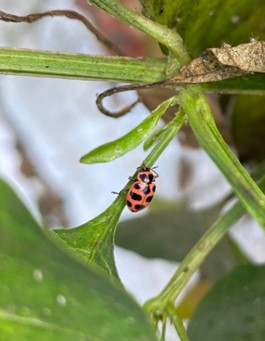
Promoting natural enemy biodiversity in greenhouses: evaluation of two banker plants
Student: Amélie Quesnel; collaborator: Geneviève Labrie (CRAM)
The use of banker plants in conservation biological control consists of the introduction of an uncultivated plant offering multiple benefits for natural enemies and biological control agents such as shelter, food, and an egg-laying site. This technique aims to sustain predator populations in the agricultural landscape leading to greater biological control potential. Among these banker plants, Lobularia maritima (Brassicales: Brassicaceae), commonly known as sweet alyssum, and Calendula officinalis (Asterales: Asteraceae) are excellent candidates, due to their long flowering period and their great source of pollen and nectar. Thus, during the summers of 2021 and 2022, these banker plants were introduced into a total of fourteen pepper and cucumber greenhouses in Quebec and an inventory of natural enemies and biological control agents was carried out.
Student: Amélie Quesnel; collaborator: Geneviève Labrie (CRAM)
The use of banker plants in conservation biological control consists of the introduction of an uncultivated plant offering multiple benefits for natural enemies and biological control agents such as shelter, food, and an egg-laying site. This technique aims to sustain predator populations in the agricultural landscape leading to greater biological control potential. Among these banker plants, Lobularia maritima (Brassicales: Brassicaceae), commonly known as sweet alyssum, and Calendula officinalis (Asterales: Asteraceae) are excellent candidates, due to their long flowering period and their great source of pollen and nectar. Thus, during the summers of 2021 and 2022, these banker plants were introduced into a total of fourteen pepper and cucumber greenhouses in Quebec and an inventory of natural enemies and biological control agents was carried out.
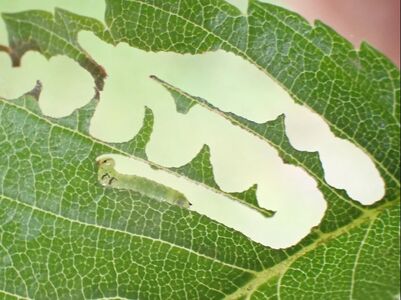
Biology of the elm zigzag sawfly in its new range in Quebec and North America
Student: Julien Lafrenière; collaborator: Véronique Martel (Natural Resources Canada)
In August 2020, the CFIA confirmed the presence of a new invasive alien species: the elm zigzag sawfly, Aproceros leucopoda Takeuchi (Hymenoptera: Argidae). Its presence was first reported in Sainte-Martine, in the Montérégie region, but was subsequently recorded throughout Quebec. The elm zigzag sawfly is a multivoltine species that is endemic in China and Japan. Aproceros leucopoda was first identified in Europe in 2003 and since then it is present in almost all countries of the continent. The elm zigzag sawfly can be a risk for elm populations that are already ravaged by Dutch elm disease. In order to assess the risk that this species represents in Quebec and Canada, and to develop a management strategy, it is important to first know its life history traits in this new habitat. The traits studied are seasonality, physiognomic characteristics and the characterization of natural enemies.
Student: Julien Lafrenière; collaborator: Véronique Martel (Natural Resources Canada)
In August 2020, the CFIA confirmed the presence of a new invasive alien species: the elm zigzag sawfly, Aproceros leucopoda Takeuchi (Hymenoptera: Argidae). Its presence was first reported in Sainte-Martine, in the Montérégie region, but was subsequently recorded throughout Quebec. The elm zigzag sawfly is a multivoltine species that is endemic in China and Japan. Aproceros leucopoda was first identified in Europe in 2003 and since then it is present in almost all countries of the continent. The elm zigzag sawfly can be a risk for elm populations that are already ravaged by Dutch elm disease. In order to assess the risk that this species represents in Quebec and Canada, and to develop a management strategy, it is important to first know its life history traits in this new habitat. The traits studied are seasonality, physiognomic characteristics and the characterization of natural enemies.
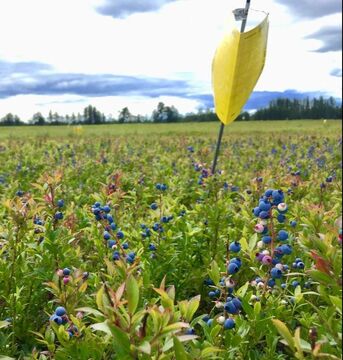
Phenology and biology of the blueberry maggot in the context of Lac-Saint-Jean
Research professional: Frédéric McCune
The newly recorded presence of blueberry maggot (Rhagoletis mendax) in the lowbush blueberry fields of Lac-Saint-Jean is of concern to the industry and could cause significant economic losses. To adopt an integrated management strategy against this new pest, it is essential to study its biology in this new environment. This project aims to study the phenology of the blueberry maggot under the climatic conditions of the region, its use of local wild hosts, and its presence in different types of habitats (natural, in vegetation and in production). To achieve the objectives of the project, wild plant fruits are harvested to detect the presence of larvae and a trapping device is established to monitor the presence of the fly in different habitats throughout the season and to establish the time of sexual maturity of the insect. Finally, a projected bioclimatic model based on thermal cumulation (degree days) will be adapted to local data.
Research professional: Frédéric McCune
The newly recorded presence of blueberry maggot (Rhagoletis mendax) in the lowbush blueberry fields of Lac-Saint-Jean is of concern to the industry and could cause significant economic losses. To adopt an integrated management strategy against this new pest, it is essential to study its biology in this new environment. This project aims to study the phenology of the blueberry maggot under the climatic conditions of the region, its use of local wild hosts, and its presence in different types of habitats (natural, in vegetation and in production). To achieve the objectives of the project, wild plant fruits are harvested to detect the presence of larvae and a trapping device is established to monitor the presence of the fly in different habitats throughout the season and to establish the time of sexual maturity of the insect. Finally, a projected bioclimatic model based on thermal cumulation (degree days) will be adapted to local data.
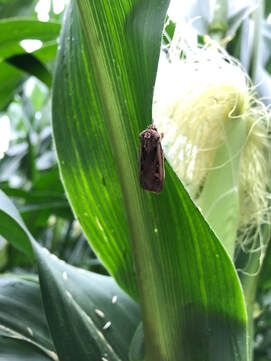
Development of an integrated pest management strategy against western bean cutworm in corn crops in Quebec
Student: Stéphanie Gervais; collaborator: Julien Saguez (CÉROM)
Western bean cutworm (Striacosta Albicosta) is an emerging pest in Quebec. The first observations of this pest insect on Quebec territory date back to 2009 and the first economic damage in 2016. Western bean cutworm mainly attacks various corn crops, causing considerable yield losses while reducing grain quality through development mycotoxin potential. Since 2010, the Réseau d’avertissement phytosanitaire (RAP) Grandes culture has monitors its population using pheromone traps to catch butterflies and in recent years scouting of egg masses and larvae has been done. Like the majority of Lepidoptera, there is no correlation between the presence of butterflies and damage, which makes it more difficult to predict the time of struggle. This project aims to determine an integrated pest management strategy with a specific intervention threshold for Quebec with different approaches including: the use of Bt corn, the presence of natural enemies and the use of low-risk insecticides, in order to carry out good integrated management of this pest and to limit the use of pesticides while respecting the health of producers and the environment.
Student: Stéphanie Gervais; collaborator: Julien Saguez (CÉROM)
Western bean cutworm (Striacosta Albicosta) is an emerging pest in Quebec. The first observations of this pest insect on Quebec territory date back to 2009 and the first economic damage in 2016. Western bean cutworm mainly attacks various corn crops, causing considerable yield losses while reducing grain quality through development mycotoxin potential. Since 2010, the Réseau d’avertissement phytosanitaire (RAP) Grandes culture has monitors its population using pheromone traps to catch butterflies and in recent years scouting of egg masses and larvae has been done. Like the majority of Lepidoptera, there is no correlation between the presence of butterflies and damage, which makes it more difficult to predict the time of struggle. This project aims to determine an integrated pest management strategy with a specific intervention threshold for Quebec with different approaches including: the use of Bt corn, the presence of natural enemies and the use of low-risk insecticides, in order to carry out good integrated management of this pest and to limit the use of pesticides while respecting the health of producers and the environment.
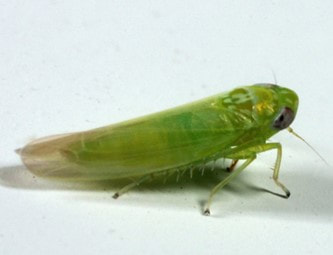
Knowledge development on leafhoppers in strawberry and their role as vectors of viral and bacterial diseases
Student in co-supervision: Nicolas Plante; principal investigator: Edel Pérez-López (Université Laval)
Leafhoppers are small insects that attack a multitude of different plants and crops. In recent years, the incidence of leafhoppers in strawberry fields has increased dramatically due to climate change. These small homoptera are causing increasingly worrying damage for strawberry producers in Quebec. Leafhoppers damage plants as they feed, but they are also vectors of bacterial and viral diseases such as phytoplasmas. Presently, there are not much information about the inventory of leafhoppers present in strawberry fields in Quebec and also about their role as vectors of phytoplasma. Thus, the results of this project will provide knowledge on the diversity and abundance of leafhoppers present in strawberry fields and will also make it possible to know which ones are vectors of phytoplasmas. Improved knowledge will also make it possible to optimize the time of intervention in the fields to avoid yield losses and reduce the overuse of pesticides.
Student in co-supervision: Nicolas Plante; principal investigator: Edel Pérez-López (Université Laval)
Leafhoppers are small insects that attack a multitude of different plants and crops. In recent years, the incidence of leafhoppers in strawberry fields has increased dramatically due to climate change. These small homoptera are causing increasingly worrying damage for strawberry producers in Quebec. Leafhoppers damage plants as they feed, but they are also vectors of bacterial and viral diseases such as phytoplasmas. Presently, there are not much information about the inventory of leafhoppers present in strawberry fields in Quebec and also about their role as vectors of phytoplasma. Thus, the results of this project will provide knowledge on the diversity and abundance of leafhoppers present in strawberry fields and will also make it possible to know which ones are vectors of phytoplasmas. Improved knowledge will also make it possible to optimize the time of intervention in the fields to avoid yield losses and reduce the overuse of pesticides.
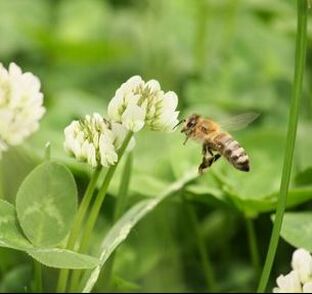
Improving the performance and resilience of urban ecosystems through the biodiversification of ground covers
Student in co-supervision: Anaïs Grenier; principal investigator: Guillaume Grégoire (Université Laval)
Lawn areas, generally composed of Kentucky bluegrass (Poa pratensis L.), are ubiquitous in urban areas. They constitute a simplified ecosystem with low plant biodiversity. Considering their spatial importance, these areas have great potential for improving biodiversity which could increase their services to the ecosystems. The search for alternatives with lower maintenance is also very interesting for municipalities. Thus, this project focuses on the introduction of herbaceous plants, their resilience to trampling and through an established lawn while trying to promote the attraction of urban pollinators. It takes place more particularly in the parks of Quebec and Montreal.
Student in co-supervision: Anaïs Grenier; principal investigator: Guillaume Grégoire (Université Laval)
Lawn areas, generally composed of Kentucky bluegrass (Poa pratensis L.), are ubiquitous in urban areas. They constitute a simplified ecosystem with low plant biodiversity. Considering their spatial importance, these areas have great potential for improving biodiversity which could increase their services to the ecosystems. The search for alternatives with lower maintenance is also very interesting for municipalities. Thus, this project focuses on the introduction of herbaceous plants, their resilience to trampling and through an established lawn while trying to promote the attraction of urban pollinators. It takes place more particularly in the parks of Quebec and Montreal.
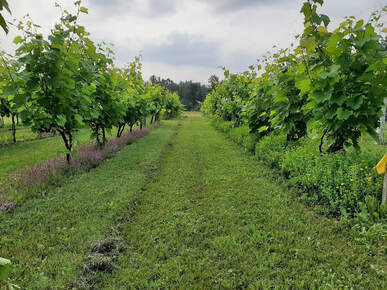
Impact of in-rows perennial cover crops on auxiliary arthropods in vineyard
Student in co-supervision: Patricia Denis; principal investigator: Caroline Halde (Université Laval)
Perennial in-row cover crops, although not widespread in Quebec, is a practice used by organic winemakers to compete with weeds, improve soil health and attract beneficial insects. However, there are no scientific studies characterizing the effects of perennial in-row cover crops in Quebec vineyards. The objective of this project is therefore to fill this gap by evaluating the effects of perennial cover crops on the ecosystem under the vine’s canopy. The results of this research will reveal whether perennial cover crops could be effective in promoting beneficial insects and weed control in vineyards. Even more, if it will be a relevant and usable in biological control.
Student in co-supervision: Patricia Denis; principal investigator: Caroline Halde (Université Laval)
Perennial in-row cover crops, although not widespread in Quebec, is a practice used by organic winemakers to compete with weeds, improve soil health and attract beneficial insects. However, there are no scientific studies characterizing the effects of perennial in-row cover crops in Quebec vineyards. The objective of this project is therefore to fill this gap by evaluating the effects of perennial cover crops on the ecosystem under the vine’s canopy. The results of this research will reveal whether perennial cover crops could be effective in promoting beneficial insects and weed control in vineyards. Even more, if it will be a relevant and usable in biological control.
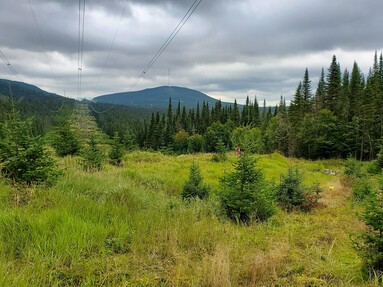
Trophic network of the spruce budworm
Student: Valentine Glaus; collaborator: Véronique Martel (Natural Resources Canada)
The aim of the study is to understand the factors affecting the interactions between the spruce budworm (SBW) parasitoids and their lepidopteran hosts. To do this, a sampling of caterpillars and parasitoids was carried out in Quebec in 2020, making it possible to harvest more than 2,000 caterpillars. Another sampling of more than 700 caterpillars was carried out in New Brunswick in 2018 and 2019 at sites where the early intervention strategy (EIS) is applied. These data will make it possible to quantify the interactions according to the following factors: level of SBW population, type of forest, presence of disturbances and use of EIS against SBW. The harvested caterpillars are analyzed by a molecular approach combining TaqMan and qPCR technologies to identify them and detect parasitoids. These data will make it possible to provide a complete portrait of the SBW food web according to the habitat and the context and to better understand the interactions between parasitoids and alternative hosts.
Student: Valentine Glaus; collaborator: Véronique Martel (Natural Resources Canada)
The aim of the study is to understand the factors affecting the interactions between the spruce budworm (SBW) parasitoids and their lepidopteran hosts. To do this, a sampling of caterpillars and parasitoids was carried out in Quebec in 2020, making it possible to harvest more than 2,000 caterpillars. Another sampling of more than 700 caterpillars was carried out in New Brunswick in 2018 and 2019 at sites where the early intervention strategy (EIS) is applied. These data will make it possible to quantify the interactions according to the following factors: level of SBW population, type of forest, presence of disturbances and use of EIS against SBW. The harvested caterpillars are analyzed by a molecular approach combining TaqMan and qPCR technologies to identify them and detect parasitoids. These data will make it possible to provide a complete portrait of the SBW food web according to the habitat and the context and to better understand the interactions between parasitoids and alternative hosts.
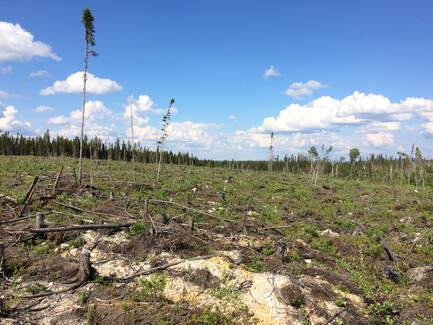
Influence of climate and floral resource on pollinator diversity in boreal forest clear-cuts
Student: Léonie Carignan-Guillemette; collaborator: Mathieu Bouchard (MFFP / Université Laval)
A growing number of studies from the United States and Europe have found a positive effect of clear-cuts on pollinators. In Quebec, a great climatic and environmental variability is visible on the territory where this type of silvicultural treatment is applied. With climate change, the ability of this anthropogenic disturbance to support our native populations of forest pollinators raises many questions. Mainly, what is the current influence of the climatic gradient and the resulting availability of the floral resource on the diversity of hoverflies and wild bees in recent clear-cuts in Quebec? This project will also allow us to identify which species will be the most vulnerable to future changes according to their distribution on the studied territory. As one of the first studies on the subject in the province, this project constitutes a considerable entomological contribution to the field of sustainable forestry in the face of climate change.
Student: Léonie Carignan-Guillemette; collaborator: Mathieu Bouchard (MFFP / Université Laval)
A growing number of studies from the United States and Europe have found a positive effect of clear-cuts on pollinators. In Quebec, a great climatic and environmental variability is visible on the territory where this type of silvicultural treatment is applied. With climate change, the ability of this anthropogenic disturbance to support our native populations of forest pollinators raises many questions. Mainly, what is the current influence of the climatic gradient and the resulting availability of the floral resource on the diversity of hoverflies and wild bees in recent clear-cuts in Quebec? This project will also allow us to identify which species will be the most vulnerable to future changes according to their distribution on the studied territory. As one of the first studies on the subject in the province, this project constitutes a considerable entomological contribution to the field of sustainable forestry in the face of climate change.

